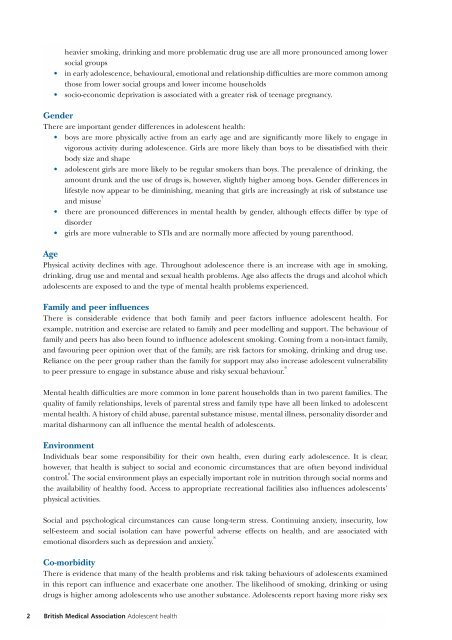Alcohol misuse: tackling the UK epidemic - London
Alcohol misuse: tackling the UK epidemic - London
Alcohol misuse: tackling the UK epidemic - London
Create successful ePaper yourself
Turn your PDF publications into a flip-book with our unique Google optimized e-Paper software.
2<br />
heavier smoking, drinking and more problematic drug use are all more pronounced among lower<br />
social groups<br />
• in early adolescence, behavioural, emotional and relationship difficulties are more common among<br />
those from lower social groups and lower income households<br />
• socio-economic deprivation is associated with a greater risk of teenage pregnancy.<br />
Gender<br />
There are important gender differences in adolescent health:<br />
• boys are more physically active from an early age and are significantly more likely to engage in<br />
vigorous activity during adolescence. Girls are more likely than boys to be dissatisfied with <strong>the</strong>ir<br />
body size and shape<br />
• adolescent girls are more likely to be regular smokers than boys. The prevalence of drinking, <strong>the</strong><br />
amount drunk and <strong>the</strong> use of drugs is, however, slightly higher among boys. Gender differences in<br />
lifestyle now appear to be diminishing, meaning that girls are increasingly at risk of substance use<br />
and <strong>misuse</strong> 7<br />
• <strong>the</strong>re are pronounced differences in mental health by gender, although effects differ by type of<br />
disorder<br />
• girls are more vulnerable to STIs and are normally more affected by young parenthood.<br />
Age<br />
Physical activity declines with age. Throughout adolescence <strong>the</strong>re is an increase with age in smoking,<br />
drinking, drug use and mental and sexual health problems. Age also affects <strong>the</strong> drugs and alcohol which<br />
adolescents are exposed to and <strong>the</strong> type of mental health problems experienced.<br />
Family and peer influences<br />
There is considerable evidence that both family and peer factors influence adolescent health. For<br />
example, nutrition and exercise are related to family and peer modelling and support. The behaviour of<br />
family and peers has also been found to influence adolescent smoking. Coming from a non-intact family,<br />
and favouring peer opinion over that of <strong>the</strong> family, are risk factors for smoking, drinking and drug use.<br />
Reliance on <strong>the</strong> peer group ra<strong>the</strong>r than <strong>the</strong> family for support may also increase adolescent vulnerability<br />
to peer pressure to engage in substance abuse and risky sexual behaviour. 6<br />
Mental health difficulties are more common in lone parent households than in two parent families. The<br />
quality of family relationships, levels of parental stress and family type have all been linked to adolescent<br />
mental health. A history of child abuse, parental substance <strong>misuse</strong>, mental illness, personality disorder and<br />
marital disharmony can all influence <strong>the</strong> mental health of adolescents.<br />
Environment<br />
Individuals bear some responsibility for <strong>the</strong>ir own health, even during early adolescence. It is clear,<br />
however, that health is subject to social and economic circumstances that are often beyond individual<br />
control. 8<br />
The social environment plays an especially important role in nutrition through social norms and<br />
<strong>the</strong> availability of healthy food. Access to appropriate recreational facilities also influences adolescents’<br />
physical activities.<br />
Social and psychological circumstances can cause long-term stress. Continuing anxiety, insecurity, low<br />
self-esteem and social isolation can have powerful adverse effects on health, and are associated with<br />
emotional disorders such as depression and anxiety. 8<br />
Co-morbidity<br />
There is evidence that many of <strong>the</strong> health problems and risk taking behaviours of adolescents examined<br />
in this report can influence and exacerbate one ano<strong>the</strong>r. The likelihood of smoking, drinking or using<br />
drugs is higher among adolescents who use ano<strong>the</strong>r substance. Adolescents report having more risky sex<br />
British Medical Association Adolescent health
















